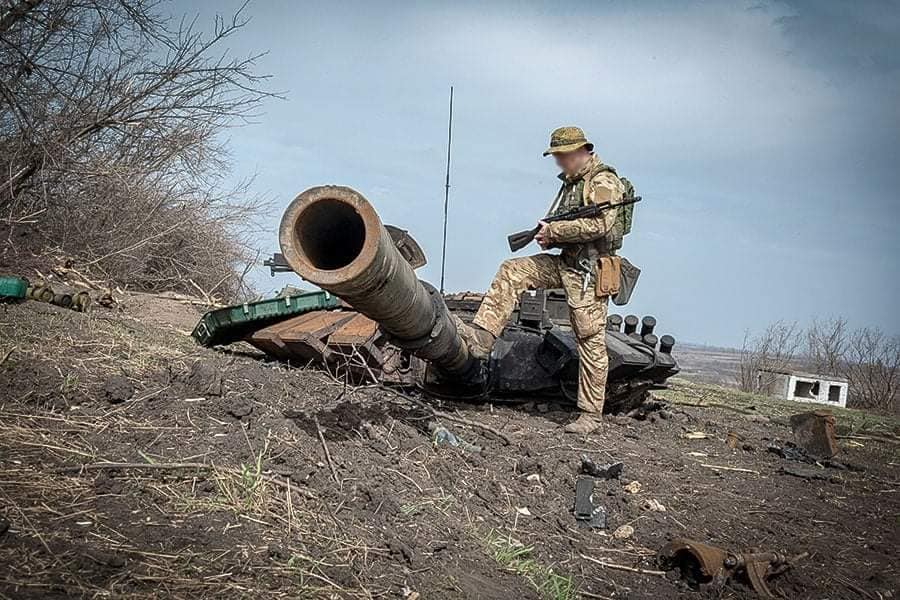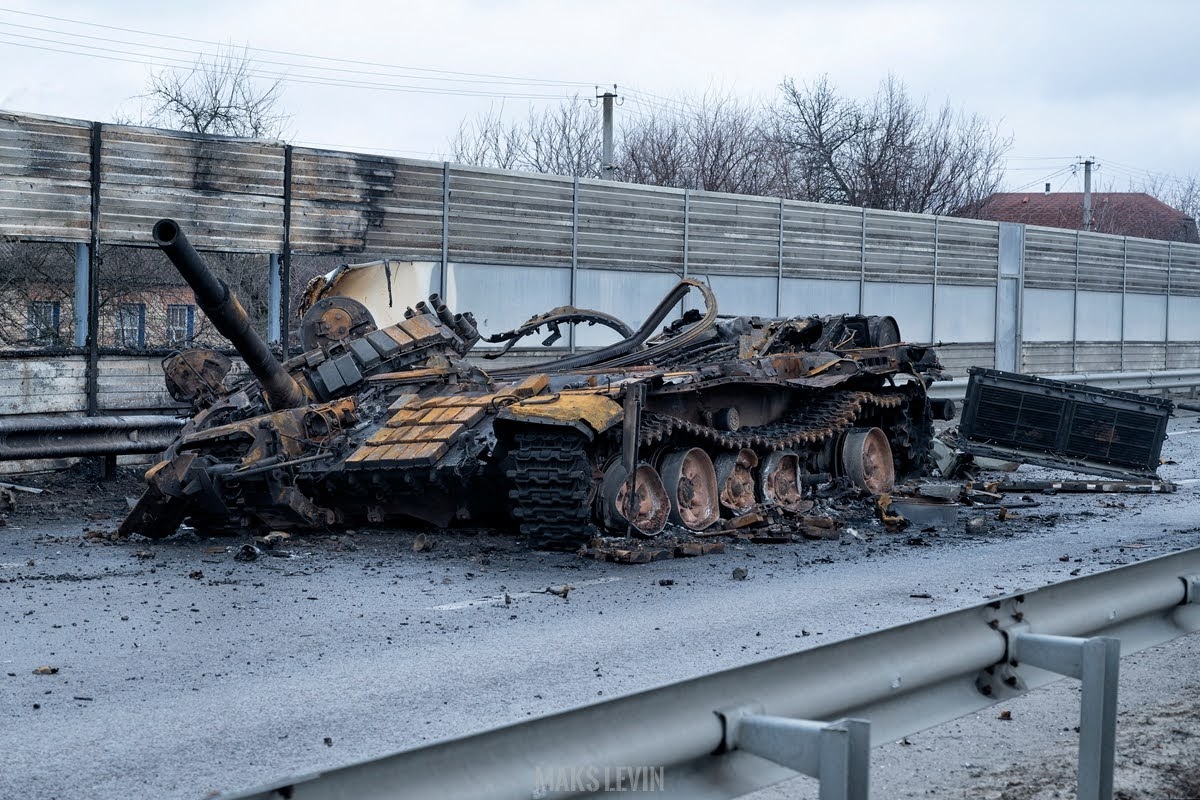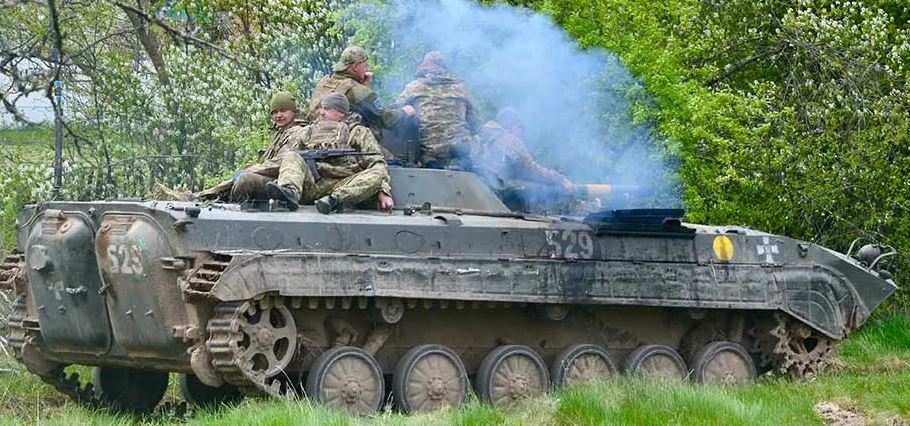AS: What does the retreat of the Russians on the northern front mean? Is this a sign that the Ukrainian forces are winning? What has led to this success?
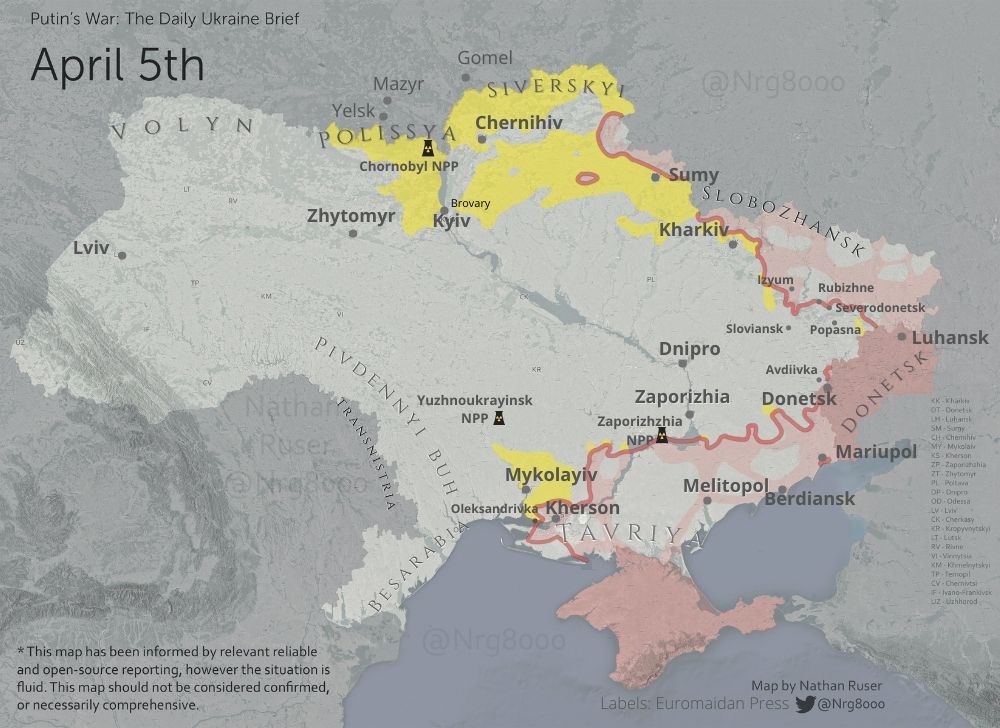
MB: Two factors have played a role.
- When the Russians were in their purely offensive phase, they did not complete their key task – they did not surround and destroy the Ukrainian forces. The Ukrainian forces were retreating with battles and constantly making the Russians pay a high price for their advance, at the same time preserving their main forces. This created preconditions for our counteroffensive. When they were repulsed on the Kyiv-Zhytomyr highway, to the north of Kyiv, near Brovary, on the Kyiv-Sumy highway, and on the approaches to Pryluky – the main reason is that the Russians were unable to implement the advantages they had to encircle and destroy our forces, and our forces survived, although they retreated while fighting;
- They have been redeployed to eastern Ukraine, to the area of the Joint Forces Operation in Donbas. They leave because they do not have enough manpower and Ukrainian forces use it to their advantage.
These two factors are behind the withdrawal of Russian forces from Kyiv. The same goes for Sumy Oblast. The redeployment of the First Guards Tank Army to the region of Izium plays a role and Ukraine uses this to free settlements and hit the enemy. They have no forces left, they need to regroup and draw everything they have to eastern Ukraine.
This gif shows the change in control across Northern Ukraine since March 31st, when Russia withdrew troops. The day before, Sumy was still under a de-facto siege. https://t.co/RofhJKSejT pic.twitter.com/Wm40eZ6uhR
— Nathan Ruser (@Nrg8000) April 3, 2022
But when they were attacking, they had a predominance of forces and equipment. Why couldn’t they take advantage of that?
There was a range of factors.
- they’re simply airheads, excuse my language, they don’t know how to fight. They were not able to use the advantages they had – to coordinate all the different types of troops, tanks, artillery, aviation;
- they were advancing on the main roads because they had no other choice.
But, it has allowed me to consistently map the progress of Russian soldiers in Ukraine over the 35-days of war. This video shows that progress and subsequent recapture of territory by Ukraine (please view in full screen as some early days are less clearly marked). pic.twitter.com/RuAT5aymRF
— Nathan Ruser (@Nrg8000) March 31, 2022
Regarding the latter, they could not fight in one place and simultaneously try to surround the Ukrainian troops in another, because when they left the main roads, they sunk in the spring mud of Ukraine’s fertile soil. Our chernozem was fighting for us! So they stayed on the main roads, where Ukrainian forces destroyed them effectively.
Also, they stretched out their communications and became extremely vulnerable regarding supply routes and guaranteeing the safety of communications, because they only controlled the roads. And even formally when the Russians were on close advances to Kyiv on the eastern bank, near Brovary, Ukrainian forces were destroying them in Chernihiv Oblast.
Firstly, a close-up of Kyiv and the axes that Russia is attacking the city from.
(The dates are cropped out, sorry).
Most importantly (imo) you can see Russia’s attempts to develop a secure supply route to Brovary that keeps getting harassed and attacked. pic.twitter.com/WvNUfUYZsD— Nathan Ruser (@Nrg8000) March 31, 2022
So, these are the results of the Russians’ inability to advance anywhere but on the main roads and couldn’t, therefore, use their main advantages, and Ukraine conducted an effective defense operation when exchanging space for time and space for exhausting the enemy is permissible.
Do I understand correctly that the Russians’ problem was that they advanced via roads, but could not hold the territory in between the roads?
That is one of the factors that made their positions unstable and allowed attacking them not only on the front but also in the rear. But the main problem was that they were confined to the roads, as their equipment sunk into Ukrainian soil as soon as they left the road.
Ukrainian forces are digging out those stuck Russian T-80U tanks.https://t.co/bgaFeXaqHB pic.twitter.com/ME8TeQVYSY
— Rob Lee (@RALee85) March 29, 2022
Ideally, it should be like this: there is the main road and several parallel roads. In one place, they should have tied us up in combat, in other places, they should have bypassed us, surrounded us, destroyed us. The Russians couldn’t implement this because they were confined to the main roads. And in the places where they tried to use this tactic, the Ukrainians met them and destroyed them.
So it’s all a consequence of the Russians being unable to use their numerical advantage. They didn’t surround the Ukrainians, didn’t destroy their forces, and themselves got weakened in the process of attacking.
It’s like the 1812 war. Napoleon entered the Russian Empire, didn’t defeat the main forces, wore out his army, and then fled. Here the situation was somewhat the same. When you don’t destroy the forces of your enemy, you only weaken your own forces and prepare the basis for his attacks.
And of course, there is the factor that they are redirecting for the east. If they didn’t redirect to the east, they could be entrenching themselves, and it would be harder. However, while doing this would be possible to the North-West of Kyiv, on the territory east of the Dnipro, it would be harder for them to become entrenched because they would be standing near the roads, where you can’t really do that.
So, it’s not only the Ukrainians’ effective defense and not only their miscalculations but also that they have to pick everything up and redeploy it to Izium.
Does their retreat to the east mean that the Russian army has exhausted its manpower?
This is one of their miscalculations. They tried to bite off more than they could chew. The 200,000 soldiers they lined up is a drop in the ocean for what they took aim at.
But they are conducting mobilization, trying to deploy units from distanced units. This all doesn’t work?
First, there is nothing left to deploy, as far as I understood from those messages.
Second, Russia has approximately 160 battalions, on the eve of the war they brought 125 to Ukraine’s borders. Formally, 35 remain, but these are, as opposed to the mix of conscripts and contract soldiers that were already thrown against Ukraine, probably just conscripts. Their combat capacity is lower than the floor. They accomplished all they were capable of, and there is nobody to replace them in the short-term perspective. So they are forced to sacrifice their positions around Kyiv and concentrate solely on the East. They won’t be able to piece together any capable force in the nearest time; it will take at least half a year.
What can we expect to happen in the East?
Heavy counter battles. Around Izium, in the area of Lysychansk, Sievierodonetsk, Rubizhne, Popasne, Svitlodarsk Arc, Avdiivka, Mariinka. The Russians will hurl everything they can at Ukraine to break through the lines of defense. Ukraine will also draw upon the reserves it has and will destroy them in active defense. These will be heavy battles. We know where they will attack, because this is all calculated beforehand, and the Russians will pay a high price.
A video by Ukraine’s General Staff shows a Ukrainian soldier using the Ukrainian-produced Stuhna system to shoot down a Russian helicopter
Do you see any signs that they have learned from their experience and are adapting their tactics?
To be honest, even if they will be more careful and will learn to coordinate the activities of their different types of troops better, i.e. work better with artillery and aviation and only then advance with infantry and armored vehicles – well, first of all, if you are facing a properly planned defense, you won’t suppress everything with artillery and aviation. And second, we won’t just sit tight, waiting for them.
What does active defense look like? It’s when their troops move forward 15-20 km and are covered by our artillery. While they try to cover and suppress us, our artillery will suppress them as well. In parallel, all that we have remaining from our heavy artillery will strike at their headquarters. Plus, our special forces will be at work. So the Russians won’t be allowed to simply destroy us.
As well, Ukraine will attack them as much as we can on the advances, and when it comes to close combat, we’ll use our NLAWs, Javelins, and so on. It will be a terrible meat grinder. Because we’ll know where the enemy will strike, they will not catch us by surprise. And Ukraine’s command will meticulously calculate where they will strike, and we’ll meet them there. Nothing good awaits them.
The Ukrainian General Staff uploaded this video showing Ukrainian tanks and armored vehicles after being hit by NLAWs and Javelins
How come the Russians could not coordinate their operations, but the Ukrainians could?
The generals played their role, but the private initiative was the most important factor. Unlike the Russians, Ukraine has less centralization. So it’s not that Ukrainian generals are better than the Russian ones, but that our soldiers simply fight much better. They have better tactics and are not confined to detailed instructions.
I remember that in 2014, the Ukrainian command was criticized for being too centralized. Can you say that the Ukrainian Army’s approach changed since 2014?
I see certain signs of this. Ukraine would never have held on to Kharkiv as it did if there was no private initiative. And in general, if we didn’t undergo decentralization and if everything needed to be coordinated with the command, we would simply not have been able to hold the front. So by and large, the fact that Ukraine is so effective in deterring the enemy is because we do not need to have everything approved. That there is an understanding that this is your defense sector, and how you keep it up is up to you, we will not decide this for you. If you need help, we will help with artillery fire or some other means. But we will not tell you in detail how to build your defense in this section, this is your task.
So in general, the fact that we withstood this invasion when the enemy had a numerical advantage and when the perimeter of the defense was so stretched out in comparison to our limited forces, is generally a sign that the Ukrainian Army’s style of management has changed.
Western partners say the Ukrainian army’s success is because it has trained to NATO standards.
Maybe they adopted some tactics; however, the war experience that the US or UK soldier has is that of a low-intensity war. Afghanistan and Iraq are incomparable to what is happening in Ukraine. The foreigners that arrive in Ukraine admit that this is something totally else, much more serious and difficult. But what has definitely worked is tactical medicine. Our soldiers got a lot of training in it, this is Ukraine’s great advantage and a result of working with the West.
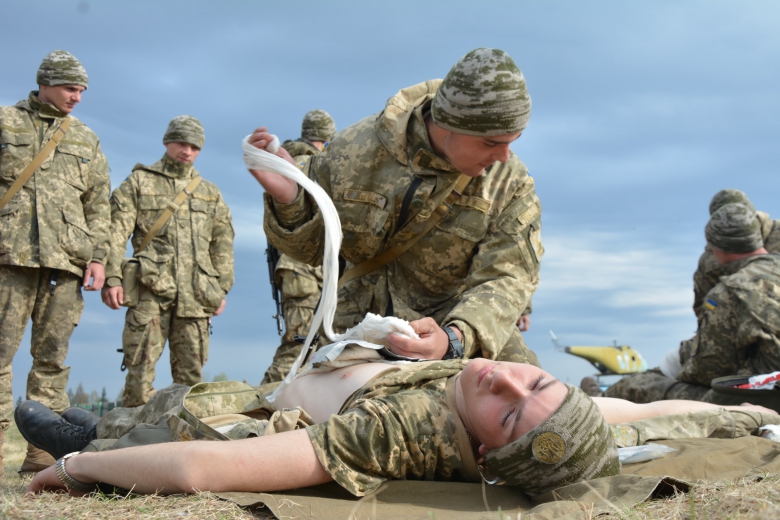
Especially if compared to what the Russian army has, the ancient Soviet standards, the lack of normal tourniquets, hemostatics, etc. But the rest… The fact that Ukrainian soldiers trained, and underwent coordination in Yavoriv was a plus for them, but to say that we could not fight without this would be an underestimation of our own merits.
Objectively, the West lacks experience in high-intensity wars. In Iraq and Afghanistan, they were fighting partisans and terrorists, and here the Ukrainians are facing an enemy that has artillery, aviation, armored vehicles, etc. So, with all due respect, our commanders and our soldiers deserve the highest merit.
What else should the West give Ukraine to help our victory?
Artillery. 155 mm caliber artillery, which will strike targets 30-40 km away. Multiple Launch Rocket Systems with a range of at least 70-80 km, missile systems with a range of up to 300 km. Artillery is the primary need. If we will have it, we will be able to exhaust the enemy more effectively. It’s one thing to fling NLAWs against tanks, but covering the enemy with massive artillery from an unknown location is something totally else. And we will be more effective in defending, and it will be easier to attack, to carry out serious offensive actions, not only to wait for the enemy to attack, but to break through their line of defense.
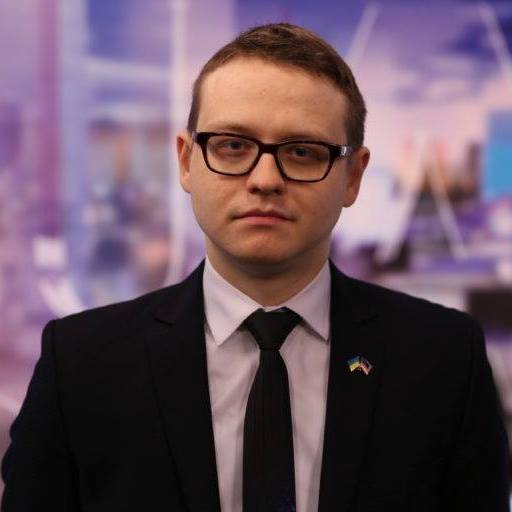
Mykola Bielieskov is a Research Fellow at the National Institute for Strategic Studies under the President of Ukraine. The expressed views are that of the author only and don’t represent the official position of National Institute for Strategic Studies.
Related:
- Ukraine’s strategy in Russian invasion: similar to Finland’s Winter War
- What weapons for Ukraine would help it win the war against Russia
- How prepared is Ukraine’s army to fight Russia in 2022?
- 70% of Chernihiv destroyed as Russian troops retreat & civilians leave bomb shelters
- Bucha massacre: Ukraine urges ICC to gather evidence of Russian war crimes




